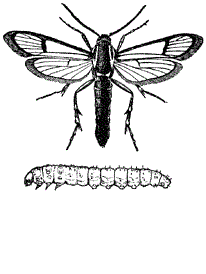 Peach Tree Borers - May 17, 2006 Jeff Schalau, County Director, Associate Agent, Agriculture & Natural Resources Arizona Cooperative Extension, Yavapai County Recently, I noticed that one of my peach trees bloomed, but is leafing out very slowly. After inspecting it more closely, I saw evidence of peach tree borer activity. The tree was certainly damaged, but I am hoping that it will pull through. It's had peach tree borers in the past, and unfortunately, once they start on a tree, it becomes weakened and can be re-colonized in subsequent years. Peach tree borers are native insects that would normally colonize native Prunus species. Commercial and backyard orchards having peach, nectarine, plum, cherry, apricot and almond trees are susceptible. Below I describe the insect, damage caused, and some management strategies that can be used. Adult peach tree borers (Synanthedon exitiosa) are steel blue to black moths with transparent wings that emerge in the late spring and early summer. They often have an orange band on their abdomen and this causes them to resemble a wasp. Females lay their eggs during summer, usually starting in June through August, on the bark at the base of tree trunks. After hatching, the larvae tunnel into the sapwood of the tree at or slightly below ground level. The larvae (caterpillars) are light brown or pinkish with a slightly darker head. Larvae feed under the bark through the summer, and move down the trunk as cold weather approaches. The partially grown larvae resume feeding in the spring. Pupation takes place under the bark, and lasts about two weeks. Moths begin to emerge in late spring, at which time mating takes place and the cycle repeats. Their feeding girdles the tree, disrupting the flow of water and nutrients in the xylem and organic compounds in the phloem. To inspect your fruit trees for peach tree borers, begin by looking for reddish-brown frass (larva fecal material) around the base of the trees. You may also see globs of sap exuding from the base of the tree. These signs indicate a larval entry point. Infested trees may also appear to be stressed (droopy leaves and dying branches). In some cases, you may need to excavate some soil at the base of the tree to see the entry points. Egg laying on older trees is usually concentrated around existing wounds. Control of existing peach tree borer infestations can help reduce future problems. Avoid damaging the bark when cultivating around trees. White paint applied to the bark around the base of the trees can help seal cracks in the bark which the female moth uses for egg laying. Individual larvae may be dug out of trees with a sharp wire. Inserting the wire into a gallery may be sufficient to kill larvae. Be careful to not injure the tree, as the damage may be as severe as that inflicted by a borer larva. This treatment is an excellent control strategy for backyard trees. Insecticide applications can be effective at controlling the early larval stages, but this only recommended for commercial operations where peach tree borer flights are monitored with pheromone traps. The traps provide site specific information to properly time insecticide applications. In older references, naphthalene crystals (mothballs or moth crystals) are often listed as a chemical. This is no longer a recommended practice due to environmental concerns. Another method of peach tree borer control uses an insect parasitic nematode, Steinernema carpocapsae. Nematodes are tiny, eel-like roundworms. This species parasitizes peachtree borer (and other Lepidopteran) larvae. Nematode applications are most effective when larvae are feeding actively and tunnel openings are largest in late summer. The nematodes are applied with a squeeze bottle in suspension with distilled water. The best preventative treatment for any pest species is proper care. You simply maintain the highest level of thrift and vigor in your orchard. Fertilize, water, avoid sunscald, prune, control weeds, and lastly, observe the trees for early signs of pest infestations. This integrated pest management approach promotes beneficial organisms and has a little or no effect on non-target species. The University of Arizona Cooperative Extension has publications and information on gardening and pest control. If you have other gardening questions, call the Master Gardener line in the Cottonwood office at 646-9113 ext. 14 or E-mail us at mgardener@verdeonline.com and be sure to include your address and phone number. Find past Backyard Gardener columns or submit column ideas at the Backyard Gardener web site: http://cals.arizona.edu/yavapai/anr/hort/byg/. |